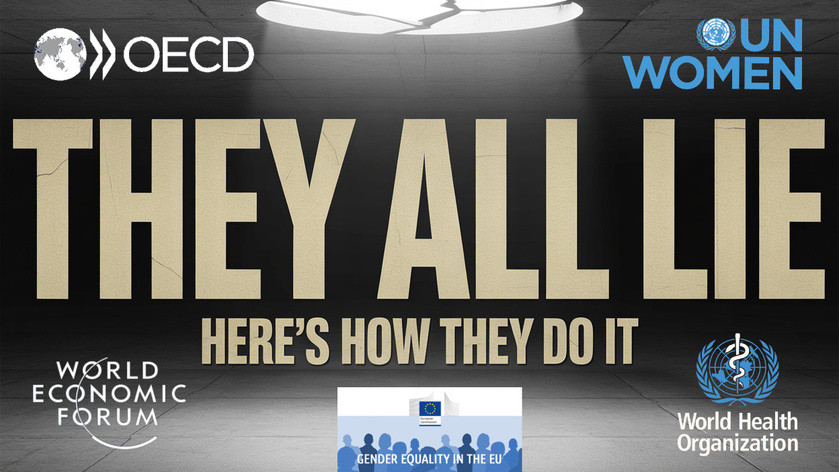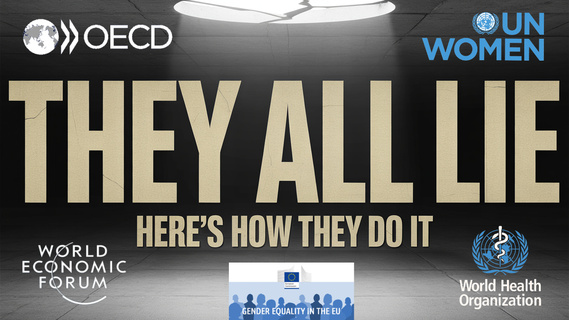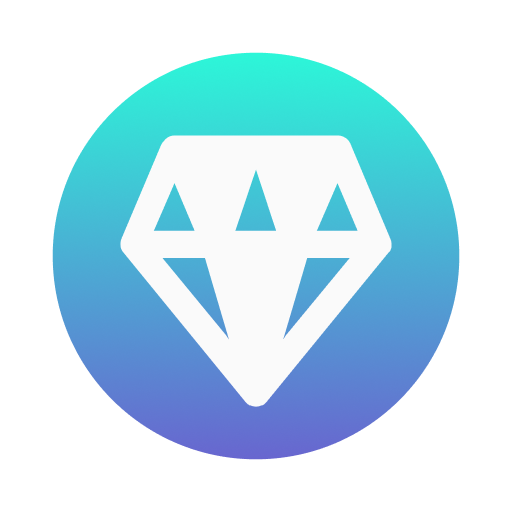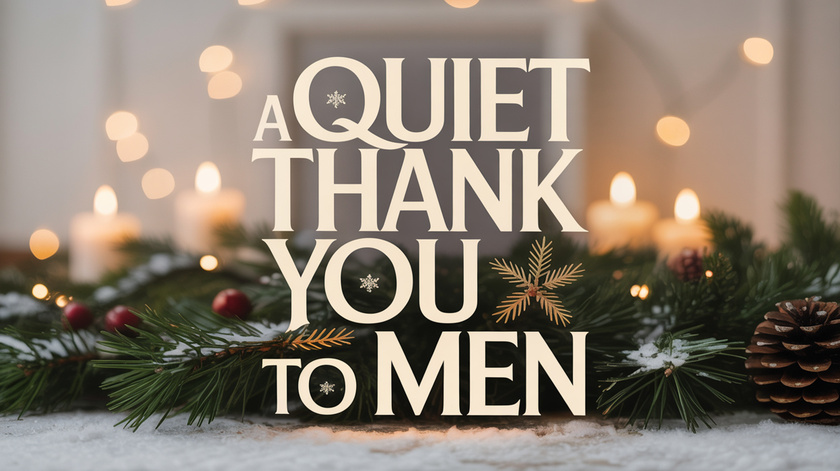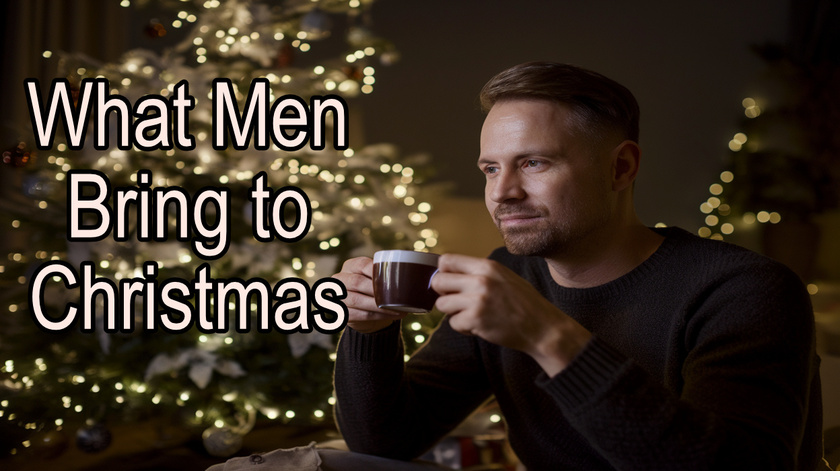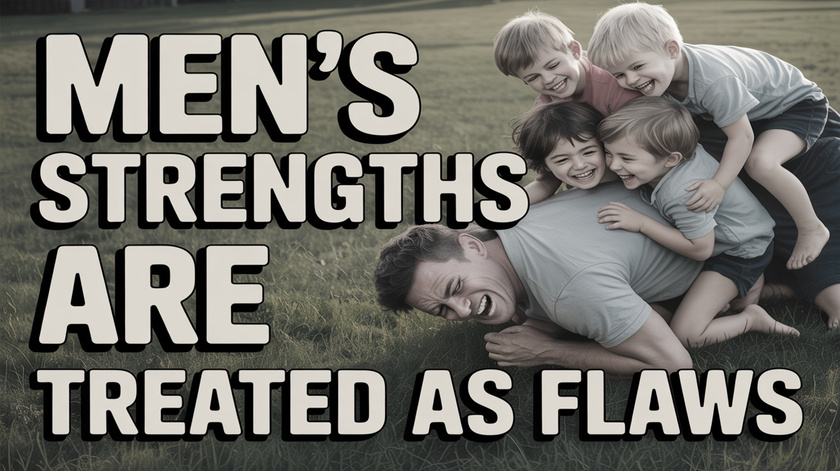They All Lie
Every year, we see it in the headlines:
“Iceland tops global gender equality ranking.”
“OECD urges countries to close gender gaps.”
“UN calls for more funding to achieve gender equity worldwide.”
Sounds fair, doesn’t it? A world where men and women both have equal chances, burdens, and protections. But scratch the surface, and you’ll see the truth: these powerful organizations measure “gender equality” in only one direction — where women are behind. Where men are behind, they look away.
Same Story, Different Logo
Here’s a very quick look at the major players:
The World Economic Forum (WEF)
Their Global Gender Gap Index famously ranks countries like Iceland as the most “gender equal” in the world. But what does it actually measure? How close women’s outcomes are to men’s — and that’s it. If women surpass men, no problem. If men fall behind — in literacy, suicide, dangerous jobs — not counted.
The OECD
This club of rich countries runs an annual Gender Data Portal. It tracks pay gaps, women in leadership, and girls in STEM. Does it track boys’ reading scores falling behind? Men’s soaring suicide rates? Men dying on the job? Not really. “Gender equity” means more women in boardrooms — not fewer men in morgues.
The United Nations (UN Women & Gender Equality Index)
The UN’s flagship Gender Inequality Index checks how far women lag in health, political power, and income. Nowhere does it penalize countries for boys dropping out of school or fathers losing access to children. The Sustainable Development Goals (SDG 5) are explicit: the goal is to “achieve gender equality and empower all women and girls.”
The European Union (EU Gender Equality Strategy)
Same blueprint: get more women in tech, more women in politics, more women at the top. Men’s mental health? Boys falling behind in classrooms across Europe? Not a funding priority.
The World Health Organization (WHO)
When the WHO talks about gender, it means women’s reproductive rights, maternal care, and violence against women. Men’s shorter life expectancy or higher suicide rates are footnotes at best — or framed as burdens on family well-being, not as gendered injustices themselves.
What Governments Do?
National governments follow suit. Canada calls its agency Women and Gender Equality Canada — but only funds programs for women and girls. The USA formerly had the White House Gender Policy Council for “women and girls.” The UK has a Minister for Women and Equalities — but no Minister for Men. There is actually an organization NACW whose mission statement says that they will "sustain, strengthen and advocate for women’s commissions." It appears there are now over 200 women's commissions in the US while Men's commissions could likely be counted on one hand. When it comes to “gender,” men have become invisible.

These organizations have developed strategies to keep the focus on women and to avoid any focus on men. This is so universal that it is hard to believe it is not intentional and conscious. With the precise and consistent omission of any vulnerability for men, it makes it very hard to believe this is not a conscious choice on their part. The best way to understand their arrogant and narcissistic choices is to look closely at the ways they choose to present their data. That is what we will do now.
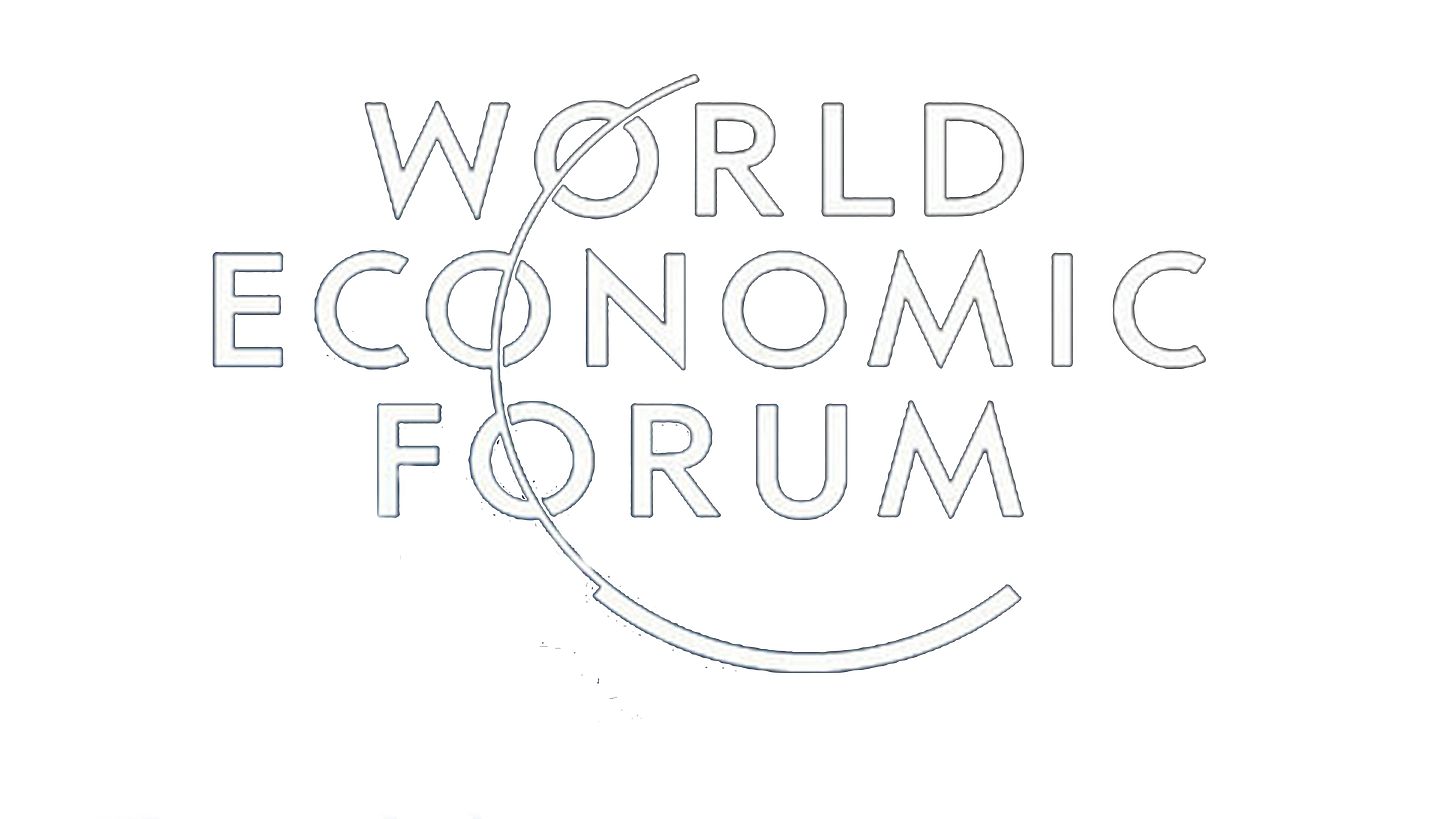
Let’s take them one by one. First up: the WEF.
The World Economic Forum is the easiest to expose for its blatant bias against men. In their 2024 Global Gender Gap Report, they let the truth slip on page 67. (Hat tip to David Geary for uncovering this gem.)
“ Hence, the index rewards countries that reach the point where outcomes for women equal those for men, but it neither rewards nor penalizes cases in which women are outperforming men in particular indicators in some countries. Thus, a country that has higher enrolment for girls rather than boys in secondary school will score equal to a country where boys’ and girls’ enrolment is the same.
Ok, can you say “Own goal?” They’ve just admitted exactly what we’ve been pointing out all along: their Global Gender Gap report is only about women — it completely ignores any disadvantages faced by men and boys. When they talk about gender equality, what they really mean is more benefits for women. This is gynocentrism in its purest form.
But it gets even worse. On page 72 of the 2025 report, they make this stunning admission:
"healthy life expectancy the equality benchmark is set at 1.06 to capture that fact that women tend to naturally live longer than men. As such, parity is considered as achieved if, on average, women live five years longer than men."
What? Parity is achieved if women live five years longer than men? Seriously? They’re claiming it’s normal — even expected — for women to outlive men? Someone should remind them of a bit of history: women didn’t consistently live longer than men until medical advances, especially in maternal and natal care, dramatically reduced deaths related to childbirth. Before that, men and women generally had equally short lifespans.
Since then, women’s longevity has increased significantly thanks to targeted medical improvements, while men’s lifespans have also improved — but not by as much. The obvious solution is not to treat women’s advantage as “natural” but to invest more resources in men’s health and close the gap. Yet instead, they take the coward’s way out, pretending women’s extra years are somehow a biological given. It’s just another glaring example of their disregard for men’s lives.
Let’s now turn our attention to another major gynocentric advocate: the OECD. We’ll be examining their 2020 OECD Gender Equality report, which is featured on YouTube. I’ve created a video analyzing this report. If you’d like to watch the full video, you can find it here.

Take a look at this chart. Notice how the pink balloons mark areas where men supposedly have "advantages" and are "doing better", while the blue balloons mark areas where women are "doing better". At first glance, this seems like a fair way to compare things — but let’s look closer.

By labeling men’s disadvantages as women’s advantages, the chart hides the reality that men face significant hardships. For example, look at the last blue balloon: it marks women’s so-called “advantage” of being less likely to be murdered. See the trick? They frame the fact that men are murdered far more often as if it’s some sort of benefit for women — neatly burying the fact that male victims even exist. It’s sneaky, and frankly, it’s deceitful.
At a glance, the chart suggests men and women have roughly equal advantages and disadvantages. But they’ve massaged the data to create this illusion. Take the first pink balloon — the one farthest from parity. It claims men have an advantage because they do less unpaid work. But when I checked U.S. data on unpaid work, I found that the difference is far smaller than the OECD figure they used.
I also noticed the balloons aren’t even accurately placed relative to the parity line. So I made my own version of the chart, which I believe is a bit more truthful. You can see it below. Now it’s clear: men’s so-called “advantages” are minimal, while women’s advantages — especially in the last three categories of less unpaid work, lower suicide rates, and lower homicide rates — are far more significant.

But even my version doesn’t fully expose the extent of their deceit. It turns out their original table used ratio data, which can distort how big or small a difference really is. ChatGPT pointed out that using linear data instead would show the actual distance from parity more accurately.
The chart below (from chatgpt) is based on that linear approach — and it reveals the truth much more clearly.

Now we’re starting to get a clearer picture of the true advantages and disadvantages. But we’re still not done. I asked ChatGPT to include a few key disadvantages for men that the OECD conveniently left out — specifically, deaths on the job and deaths in war — and to add these to the list of female “advantages.”
Take a look at the updated chart now:

And then I asked it to include genital mutilation and the so called "male advantages" all but disappeared:

I hope you can see now how the first OECD chart was hiding things in a most unscrupulous way. Before we go to the next organization I would like to share another way the OECD diminished men and held a steady focus on women. At one point in their report they examined deaths of despair. Unlike the other sections of the report this section did not break things down by sex. If they had it would have been unmistakable that men were facing a huge disadvantage. Can't show that. Instead they showed the data by country and compared the deaths of despair by country and not mentioning the sex breakdown. You can see this in the chart below.

After that, the moderator downplayed the significance of the 'deaths of despair,' suggesting they were not particularly important since they only accounted for 2% of all deaths and were typically linked to mental illness. At that point, the graphic below appears in the pink square in the bottom right corner:
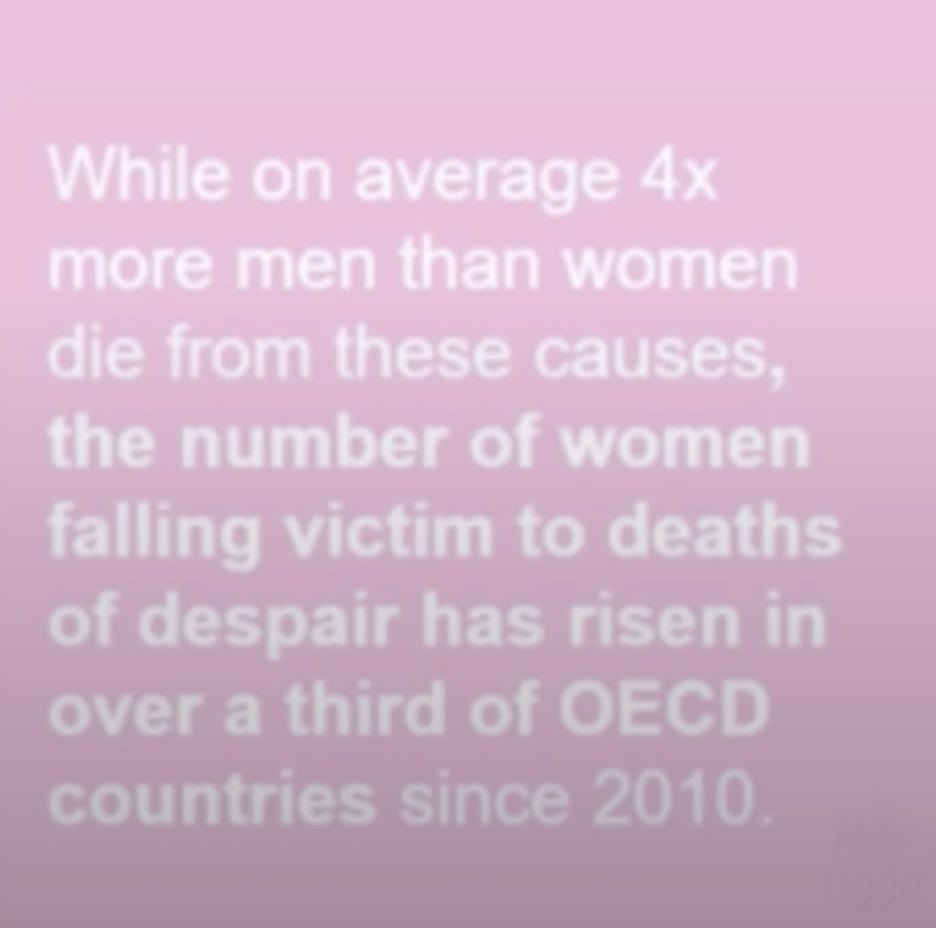
For the short time that this graphic displays the moderator says the following "although almost four times more men than women die of deaths of despair, the number of women that fall victim to such fatalities has actually risen since 2010 in more than one third of OECD countries so there is some concerning pattern going on here that deserves much more research going forward."
Really? At least they admitted that 4x as many men die of deaths of despair but now they minimize that. She says that yes, men are more often dying from deaths of despair but there is a trend in the minority of countries that shows women's deaths of despair rising, so that should be researched! So the important thing is not that men are 4x more likely to die, it is that, "Oh no!" women's deaths are increasing in the minority of countries! Blatant disregard for men's lives.
Let's move on to the EU.
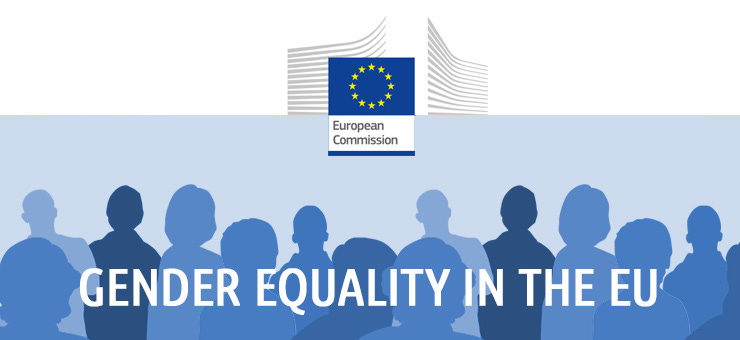
EU “Gender Equality” Is Anything But Equal
The European Union calls its Gender Equality Strategy “a Union of Equality.” Look at the logo, it seems to be both men and women. But scratch the surface, and you find something else: an official plan that sees “equality” as lifting women up — and pretending men’s disadvantages don’t exist.
Right from the first pages, the EU declares:
“The EU promotes gender equality and women’s empowerment in its policies.”
Fine. But where does it mention boys falling behind girls in school? Or men’s suicide crisis — which dwarfs women’s? Or fathers’ struggles in family court? Nowhere.
It defines gender-based violence as something that “is directed against a woman because she is a woman or that affects women disproportionately.” Male victims are invisible by definition.
When masculinity is mentioned, it’s only as a problem to be “fixed”:
“Violence prevention focusing on men, boys and masculinities will be of central importance.”
In other words: men are a risk to manage, not a group to protect.
It promises to close the imaginary gender pay gap — but says nothing about men doing the deadliest jobs, with zero life expectancy benefit for all that risk. And when it comes to leadership and boardrooms, men are painted as the default oppressors.
Is this equality? Or a one-sided upgrade plan for women, paid for with men’s silence?
A real Union of Equality would help girls and boys, protect women and men, and close gaps in both directions. Until that happens, this strategy isn’t gender equality — it’s selective compassion in a fancy wrapper.

The UN’s Gender Inequality Index (GII) is widely cited as a global measure of progress toward gender equality — but if you look closely, it’s not really an equality measure at all. It’s a tool designed solely to track female disadvantage in three areas: reproductive health, empowerment, and labor market participation. Countries get a better score when women’s outcomes in these categories improve relative to men’s. But nowhere in the index is there any penalty when men face worse outcomes. So when boys underperform girls in education (which they now do in many countries), it doesn’t hurt a nation’s score at all. When men die by suicide at far higher rates than women, that gender gap doesn’t count. When men face higher workplace deaths, harsher sentencing, or greater homelessness, these realities are invisible to the GII’s math.
In effect, the GII is not an “inequality” index — it’s a female advancement index dressed up as an impartial measure of fairness. It rewards governments for improving conditions for women while ignoring areas where men suffer clear, documented disadvantages. This one-sided design skews public policy: it signals to leaders and donors that the gender problem is always about lifting women up, never about helping men when they fall behind. So billions flow toward closing “gaps” that only run one way. Until the UN acknowledges the full spectrum of gendered hardship — for men as well as women — its flagship index will continue to be a selective measure, promoting partial solutions under the banner of “equality.”

The World Health Organization (WHO) often frames itself as a champion of gender equality in health. But dig into their gender policies, and you’ll see that for the WHO, “gender” overwhelmingly means women’s health and well-being. Their gender strategies focus heavily on improving maternal care, preventing violence against women, and protecting women’s reproductive rights — all of which are important. But when it comes to men’s stark health disadvantages, the WHO tends to stay silent or treat men’s suffering as a side note rather than a gender issue worth tackling head-on. For example, men have consistently shorter life expectancies worldwide, higher rates of occupational injury, greater substance abuse, and far higher suicide rates — yet these trends rarely drive funding or targeted intervention the way maternal mortality does.
When the WHO does mention men, it’s often to point out how their reluctance to seek care negatively impacts families and communities — in other words, men’s poor health is framed as a burden on others, not as a human cost in its own right. This one-sided approach means men’s unique health risks remain under-researched and underfunded. True gender equality in health would mean acknowledging that both sexes have distinct vulnerabilities — and designing programs that don’t just lift up women, but also address the silent crises shortening men’s lives every day. Until then, the WHO’s “gender equality” remains an incomplete promise, built on selective compassion that too often leaves men out of the picture.
The Scorecard
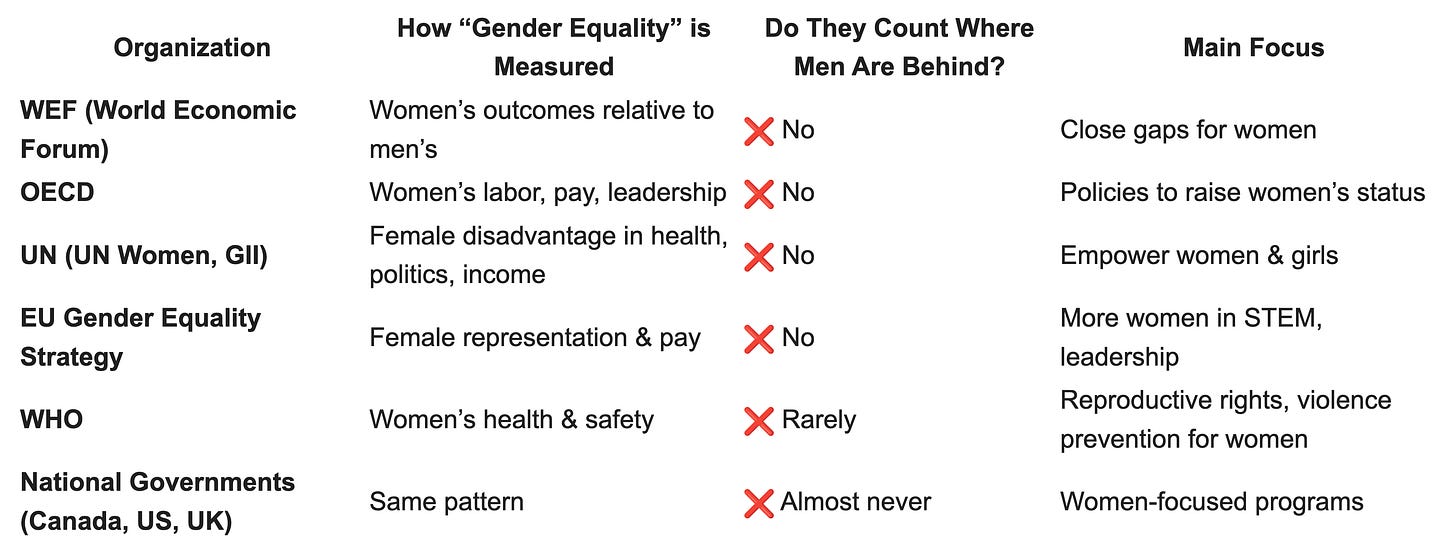
The bottom line: These powerful institutions — from global think tanks to national governments — carefully craft and repeat a one-sided story. They use selective statistics, vague slogans, and cleverly framed charts to keep public attention fixed on the challenges women face, while systematically ignoring or minimizing the very real struggles of men and boys. As a result, the public is fed a comforting illusion: that “gender equality” is an unbiased, balanced goal steadily being achieved.
In truth, this narrative is built on selective compassion. When women fall behind, it’s treated as an urgent crisis requiring funding, laws, and campaigns. When men fall behind — in education, mental health, life expectancy, or family courts — it’s brushed aside, hidden behind technical language, or reframed as women’s “advantage.” This imbalance isn’t just an academic quirk; it shapes how billions of dollars are spent, how policies are written, and how generations learn to see gender fairness as a cause that only flows in one direction.
A truly honest commitment to gender equality would mean looking courageously at where both sexes struggle — and taking real action to close all gaps, regardless of who is disadvantaged. It would mean caring that boys now trail girls in school achievement across the developed world; caring that men die by suicide far more often; caring that dangerous jobs, war deaths, and social isolation disproportionately burden men.
Until these realities are openly acknowledged and addressed, “gender equality” will remain, at best, a half-truth — and at worst, a comforting slogan used to mask deep double standards and selective concern. Real fairness demands more than slogans. It demands the courage to see everyone’s burdens, not just the ones that fit a preferred narrative.
